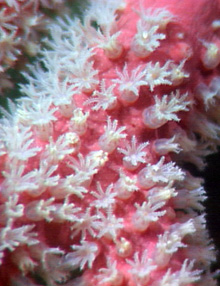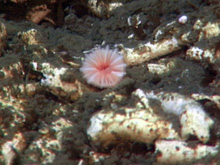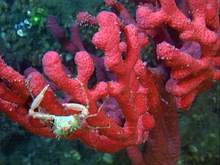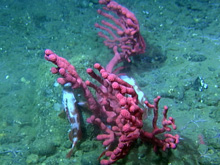
Close up of individual polyps of the colonial octocoral Paragorgia. Corals are in the phylum Cnidaria – the same phylum that anemones are in. Notice the similarities? Click image for larger view and image credit.
What Are Deep-Sea Corals and Why Do We Care?
Jeff Hyland
National Centers for Coastal Ocean Science
Deep-sea corals are a group of fascinating organisms within the invertebrate phylum Cnidaria. Like all corals and members of the phylum Cnidaria, deep-sea corals possess modified stinging cells (as portrayed by its Greek root word “cnidos” meaning stinging nettle) for protection and to assist in the capturing of prey. The deep sea corals include several families of octocorals (subclass Alcyonaria, class Anthozoa), hexacorals (subclass Zoantharia, class Anthozoa), and hydrocorals (subclass Athecatae, class Hydrozoa). They occur throughout coastal-ocean waters in deeper (generally more than 80 meters or 260 feet) and colder habitats. They live beyond the boundaries of the sunlit shallows we associate with nearshore tropical reef ecosystems. Most live on hard substrates on the seafloor, such as boulders and rocky outcrops, and can appear in various sizes and forms from massive reefs, tens of meters high, to individual colonies less than a meter high. Species large enough and complex enough to support associated invertebrates and fishes also have been called “habitat-forming” deep-sea corals (Etnoyer and Morgan 2003). Prime examples of such corals in the U.S. include the scleractinian (stony) hexacorals Lophelia pertusa and Oculina varicosa. Unlike most tropical shallow-water species, deep-sea corals lack zooxanthellae, the symbiotic photosynthetic algae that produce food from sunlight, which is absent or limited at the depths where deep-sea corals typically occur.

The habitat forming Lophelia pertusa forms litho- or bioherms of skeletal material upon which new parts of the colony grow. The pink structure in the center of the photo is the living portion of the colony. The skeletal material provides habitat for other organisms as well. Click image for larger view and image credit.
Why do we care about deep-sea corals? First, their complex three-dimensional structure creates habitat for diverse communities of invertebrates and fishes, including commercially important species such as rockfish, shrimp, and crab. Some deep-sea corals may also be sources of compounds for the development of new drugs and medical treatments. However, due to their exposed structure, slow growth and recruitment rates, deep-sea corals may be especially vulnerable to natural or human disturbance such as bottom trawling, mineral extraction, and cable trenching — activities that result in physical disruption of the seafloor. Such disturbances could require very long periods for the coral communities to recover. Many nations are beginning to recognize the value of deep-sea corals and take steps to manage and protect them. With the availability of new underwater survey technologies have come recent scientific surveys and new opportunities to document more of these resources. A recent international symposium on deep-sea corals, held November 28-December 2, 2005, in Miami, FL provides an excellent example of the abundance of new studies and activities pertaining to this topic (see website at http://www.conference.ifas.ufl.edu/coral ![]()
![]() ).
).

Paragorgia colonies also provide habitat for diverse arrays of invertebrates, such as crab and shrimp. Click image for larger view and image credit.
References and other suggested reading:
Etnoyer, P. and L. Morgan. 2003. Occurrences of habitat-forming deep sea corals in the northeast Pacific Ocean. Marine Conservation Biology Institute, Redmond WA and National Oceanic Atmospheric Administration, Silver Spring MD.
Freiwald, A. and M.M. Roberts (eds.) 2005. Cold-water corals and ecosytems. Springer-Verlag, Berlin.
Guinotte, J.M., J. Orr, S. Cairns, A. Freiwald, L. Morgan, and R. George. 2006. "Will human-induced changes in seawater chemistry alter the distribution of deep-sea scleractinian corals?" Front. Ecol. Environ., 4: 141-146.
Hain, S. et al. 2004. "The status of the cold-water coral reefs of the world." In: C. Wilkinson (ed.) Status of Coral Reefs of the World: 2004, Vol. 1. Australian Institute of Marine Sciences, Townsville. 115-135.
Hyland, J., C. Cooksey, E. Bowlby, M.S. Brancato, and S. Intelmann. 2005. "A Pilot Survey of Deepwater Coral/Sponge Assemblages and their Susceptibility to Fishing/Harvest Impacts at the Olympic Coast National Marine Sanctuary (OCNMS)." Cruise Report for NOAA Ship McARTHUR II Cruise AR-04-04: Leg 2. NOAA Tech. Memo. NOS NCCOS 15. NOAA/NOS/CCEHBR, Charleston, SC. 13 p.
Morgan, L.E., C.F. Tsao, J.M. Guinotte. 2006. Status of deep sea corals in U.S. waters, with recommendations for their conservation and management. Marine Conservation Biology Institute, Bellevue, WA. 64.
Sign up for the Ocean Explorer E-mail Update List.














